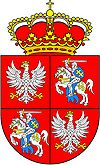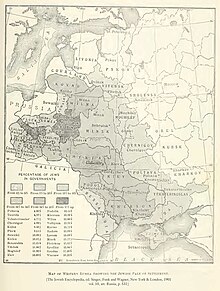| Revision as of 10:59, 25 December 2006 editHumus sapiens (talk | contribs)27,653 edits →Jewish atrocties during the Ukrainian famine: rm this section full of WP:OR & WP:WEASEL allegations← Previous edit | Revision as of 11:01, 25 December 2006 edit undoHillock65 (talk | contribs)4,431 edits rv Please do not remove without discussion!Next edit → | ||
| Line 86: | Line 86: | ||
| == October Revolution == | == October Revolution == | ||
| {{main|October Revolution |
{{main|October Revolution}} | ||
| === Jewish participation in revolutionary terror === | |||
| Persons of Jewish origin were over-represented in the Russian revolutionary leadership. However, most of them were hostile to traditional ] and Jewish political parties, and were eager to prove their loyalty to the ]'s ] and ], and committed to stamp out any sign of "Jewish cultural particularism". | |||
| ] | |||
| The territory of Ukraine contained one of the largest Jewish populations in Europe and in many ways due to the laws, like the ] the plight of ordinary Jews was not easy. However, as the laws were finally repealed, a number of Jews finally got an access to Universities and other higher educational establishments, where they, like many others were exposed to the revolutinary ideas sweeping Europe. In fact, the Russian Interior ministry got encreasingly warried besause of the high number of Jewish students involved in the revolutionary activity. And indeed, with the victory of the Bolsheviks in 1917 many of the Jews, particularly from Ukraine advanced to the leading positions in the Bolshevik Government. Two prominent representatives of the Ukrainian Jewish community ] (Leon Bronstein) and ] even advanced to the leading positions in the Soviet Government. | |||
| In the throes of the revolution along with others, Ukrainian Jews actively participated in the terror unleashed on the population of Ukraine. In his article of ], ] "Zionism versus Bolshevism" Sir ] describes the role of Jews in the revolutionary terror in the following way: | |||
| ::''"With the notable exception of Lenin, the majority of the leading figures are Jews. Moreover, the principal inspiration and driving power comes from the Jewish leaders. Thus Tchitcherin, a pure Russian, is eclipsed by his nominal subordinate Litvinoff, and the influence of Russians like Bukharin or ] cannot be compared with the power of ], or of ], the Dictator of the Red Citadel (Petrograd), or of ] or ] -- all Jews. In the Soviet institutions the predominance of Jews is even more astonishing. And the prominent, if not indeed the principal, part in the system of terrorism applied by the Extraordinary Commissions for Combating Counter-Revolution has been taken by Jews, and in some notable cases by Jewesses."'' | |||
| Jewish Bolsheviks from Ukraine played prominent roles in the Russian Revolution including, among others, ] (Bronstein), ] (Apfelbaum), ], ], and ]. Significant numbers of Jews did sign on to Bolshevik ideas of revolutionary terror that caused unprecedented loss of freedom, poverty, oppression and death. During the reign of ] unleashed on the populations of Ukraine and Russia hundreds of thousands mostly innocent people died, some of them Jews as well. | |||
| == Ukrainian Soviet Socialist Republic == | == Ukrainian Soviet Socialist Republic == | ||
| Line 116: | Line 125: | ||
| {{main|Interbellum}} | {{main|Interbellum}} | ||
| === Jewish atrocties during the Ukrainian famine === | |||
| ]". The exact number of deaths is hotly argued. See ] article for details]] | |||
| An accusation in the genocide against civilian population has been made against another ethnic Jew from Ukraine - ]. Togethter with ], Kaganovich took part in the All-Ukrainian Party Conference of ] and actively encouraged the policies of collectivization there, which, as many historians argue led to the catastrophic ]-] Ukrainian famine (the ]). As the result, millions of Ukrainians died during this artificial catastrophe. Similar policies also inflicted enormous suffering on the Soviet Central Asian republic of Kazakhstan, the Kuban region, Crimea, the lower Volga region, and other parts of the Soviet Union. Lazar Kaganovich is viewed by many if not as the mastermind but an active participant in this genocide. | |||
| == Ukraine in World War II == | == Ukraine in World War II == | ||
Revision as of 11:01, 25 December 2006
History of the Jews in Ukraine
Kievan Rus’

Jewish settlements in Ukraine can be traced back to the 8th century. Jewish refugees from the Byzantine Empire, Persia, and Mesopotamia, fleeing from persecution by Christians throughout Europe, settled in the Khazar Khaganate.
The 11th century Byzantine Jews of Constantinople had family, cultural, and theological ties with the Jews of Kiev. For instance, some 11th-century Jews from Kievan Rus were participants in an anti-Karaite assembly held in either Thessalonica or Constantinople.
Halych-Volynia/14th Century
Main article: Halych-Volynia Main article: 14th centuryIn Halychyna, the westernmost area of Ukraine, the Jews were mentioned for the first time in 1030. From the second part of the 14th century, they were under the patronage of the Polish kings and magnates. The Jewish population of Halychyna and Bukovyna, part of the Austro-Hungarian Empire, was extremely large; it made up 5% of the world Jewish population.
Polish-Lithuanian Commonwealth

From the founding of the Kingdom of Poland in the 10th century through the creation of the Polish-Lithuanian Commonwealth in 1569, Poland was one of the most tolerant countries in Europe. It became home to one of the world's largest and most vibrant Jewish communities.
Cossack era
Main article: Khmelnytskyi UprisingBohdan Khmelnytsky told the people that the Poles had sold them as slaves "into the hands of the accursed Jews." With this as their battle-cry, the Cossacks massacred a huge number of Jews during the years 1648–1649. The precise number of dead may never be known, but estimates range from a minimum 50,000 to several hundred thousands Jews killed: 300 Jewish communities were totally destroyed. The Polish-Lithuanian Commonwealth population losses in the Khmelnytskyi Uprising were over one million citizens killed. In reprisals, many thousands of Cossacks and peasantry supporting them were also murdered.
Russian and Austrian rule

The traditional measures of keeping Imperial Russia free of Jews failed when the main territory of Polish-Lithuanian Commonwealth was annexed during the partitions of Poland. During the second (1793) and the third (1795) partitions, large populations of Jews were taken over by Russia, and Catherine II of Russia established the Pale of Settlement that included Congress Poland and Crimea.


See also
Russian Revolution of 1905

Counterrevolutionary groups, including the Black Hundreds, opposed the revolution with violent attacks on socialists and pogroms against Jews. The concessions came hand-in-hand with renewed, and brutal, action against the unrest. There was also a backlash from the conservative elements of society, notably in spasmodic anti-Jewish attacks — around five hundred were killed in a single day in Odessa. Nicholas II of Russia himself claimed that 90% of revolutionaries were Jews.
- Menahem Mendel Beilis
- Dmitry Bogrov
- Rose Pesotta
- Saša Schlümper (Samuil Nahimovich Beilin)
- Ida Silberblatt
- General Jewish Labor Union
First World War
Main article: World War IFebruary Revolution
Main article: February RevolutionUkrainian People's Republic
During the rule of Symon Petlura, a series of mass pogroms were perpetrated against the Jews of Ukraine. Estimated 100,000 of civilian Jews were murdered. Some historians have claimed that Petliura did nothing to stop the pogroms, but some have claimed that he himself was not an anti-Semite and he tried to stop them by introducing capital punishment for the crime of pogromming, and that Petliura's only crime was being the head of state of country where the pogroms happened.
October Revolution
Main article: October RevolutionJewish participation in revolutionary terror

The territory of Ukraine contained one of the largest Jewish populations in Europe and in many ways due to the laws, like the Pale of Settlement the plight of ordinary Jews was not easy. However, as the laws were finally repealed, a number of Jews finally got an access to Universities and other higher educational establishments, where they, like many others were exposed to the revolutinary ideas sweeping Europe. In fact, the Russian Interior ministry got encreasingly warried besause of the high number of Jewish students involved in the revolutionary activity. And indeed, with the victory of the Bolsheviks in 1917 many of the Jews, particularly from Ukraine advanced to the leading positions in the Bolshevik Government. Two prominent representatives of the Ukrainian Jewish community Leon Trotsky (Leon Bronstein) and Lazar Kaganovich even advanced to the leading positions in the Soviet Government.
In the throes of the revolution along with others, Ukrainian Jews actively participated in the terror unleashed on the population of Ukraine. In his article of February 8, 1920 "Zionism versus Bolshevism" Sir Winston Churchil describes the role of Jews in the revolutionary terror in the following way:
- "With the notable exception of Lenin, the majority of the leading figures are Jews. Moreover, the principal inspiration and driving power comes from the Jewish leaders. Thus Tchitcherin, a pure Russian, is eclipsed by his nominal subordinate Litvinoff, and the influence of Russians like Bukharin or Lunacharski cannot be compared with the power of Trotsky, or of Zinovieff, the Dictator of the Red Citadel (Petrograd), or of Krassin or Radek -- all Jews. In the Soviet institutions the predominance of Jews is even more astonishing. And the prominent, if not indeed the principal, part in the system of terrorism applied by the Extraordinary Commissions for Combating Counter-Revolution has been taken by Jews, and in some notable cases by Jewesses."
Jewish Bolsheviks from Ukraine played prominent roles in the Russian Revolution including, among others, Trotsky (Bronstein), Zinoviev (Apfelbaum), Kamenev, Radek, and Uritsky. Significant numbers of Jews did sign on to Bolshevik ideas of revolutionary terror that caused unprecedented loss of freedom, poverty, oppression and death. During the reign of Red Terror unleashed on the populations of Ukraine and Russia hundreds of thousands mostly innocent people died, some of them Jews as well.
Ukrainian Soviet Socialist Republic
Main article: Ukrainian Soviet Socialist RepublicUkrainian Revolution


There were many Jews in the Black Guards, and in the Revolutionary Insurrectionary Army of Ukraine.
See also
Ukraine between the world wars
Main article: InterbellumJewish atrocties during the Ukrainian famine
An accusation in the genocide against civilian population has been made against another ethnic Jew from Ukraine - Lazar Kaganovich. Togethter with Vyacheslav Molotov, Kaganovich took part in the All-Ukrainian Party Conference of 1930 and actively encouraged the policies of collectivization there, which, as many historians argue led to the catastrophic 1932-1933 Ukrainian famine (the Holodomor). As the result, millions of Ukrainians died during this artificial catastrophe. Similar policies also inflicted enormous suffering on the Soviet Central Asian republic of Kazakhstan, the Kuban region, Crimea, the lower Volga region, and other parts of the Soviet Union. Lazar Kaganovich is viewed by many if not as the mastermind but an active participant in this genocide.
Ukraine in World War II

This image has an uncertain copyright status and is pending deletion. You can comment on the removal.
Total civilian losses during the war and German occupation in Ukraine are estimated at seven million, including over a million Jews shot and killed by the Einsatzgruppen and Ukrainian collaborators. Jews were also targeted by Ukrainian nationalists in Nazi-backed pogroms, such as the ones in Lviv that killed over six thousand people.
See also
Post-war

Independence

See also
- Beilis trial
- Black Hundred
- Cantonist
- Galician Jews
- History of the Jews in Russia and the Soviet Union
- Jewish gauchos
- Reichskommissariat Ukraine
| History of the Jews in Europe | |
|---|---|
| Sovereign states |
|
| States with limited recognition | |
| Dependencies and other entities | |